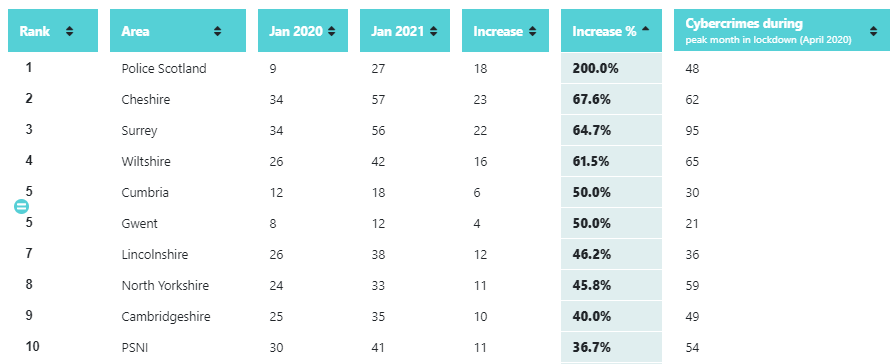A new study into cybercrime reveals the most common types of cybercrime across the UK and the areas with the highest rates. The data shows a 19.1% increase in overall UK cybercrime levels between January 2020 and January 2021.
LONDON, UK – April 2021 – During the coronavirus pandemic, the UK has seen a cybercrime increase of 19.1%. ESET, a global leader in cybersecurity, has conducted a study to reveal the UK areas with the highest rates of cybercrime, the areas where cybercrime is rising most rapidly and the most common types of cybercrime.
The UK areas with the highest rate of cybercrime:
According to the data, London is the worst place in the UK for cybercrime, with 66.3 in every 100,000 people falling victim last year, totalling 5,934 cybercrime attacks amongst its 8,952,300 population in 2020 alone.
Hertfordshire takes second place with 63 per 100,000 people falling victim to cybercrimes. There were 749 cybercrime attacks in 2020 across a population of 1,189,500.
Wiltshire and Kent both come in at third with 58.8 per 100,000 people becoming victims of cybercrime in both areas in 2020.
The UK areas with the biggest increase in cybercrime:
The biggest jump in cybercrime was seen by Police Scotland, which recorded a huge 200% increase from January 2020 to January 2021. Coming in second is Cheshire, which saw a 67.6% increase – followed closely by Surrey, with a 64.7% increase in reported cybercrime.
The UK Cybercrime Report found around three-quarters of reported cybercrimes in the UK fell under 'hacking', with just under a quarter involving the installation of computer viruses, malware and spyware.
Commenting on the study Jake Moore, Cybersecurity Specialist at ESET, said: “What is initially apparent is that there has been a nationwide increase and cybercriminals will pursue the data rather than target people specifically. However, knowledge is the key to reducing cybercrime and where this data has highlighted inevitable increases, it may suggest those areas are lacking in cybersecurity awareness and a focus on education is now necessary.”
You can view the full research on Cybercrime Cities at the ESET website.
Methodology
The cybercrime data was sourced from the City of London Police's NFIB Fraud and Cybercrime Dashboard and refers to crime committed during 2020.
The population data was sourced from ONS Crime in England and Wales data.
To calculate the annual increase, data was used from January 2020 and January 2021.
The data is accurate up to 26th March 2021.
About ESET
For more than 30 years, ESET® has been developing industry-leading IT security software and services to protect businesses, critical infrastructure and consumers worldwide from increasingly sophisticated digital threats. From endpoint and mobile security to endpoint detection and response, as well as encryption and multi-factor authentication, ESET’s high-performing, easy-to-use solutions unobtrusively protect and monitor 24/7, updating defences in real time to keep users safe and businesses running without interruption. Evolving threats require an evolving IT security company that enables the safe use of technology. This is backed by ESET’s R&D centres worldwide, working in support of our shared future. For more information, visit our website or follow us on LinkedIn, Facebook, and Twitter.

